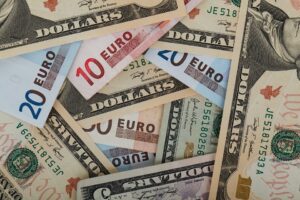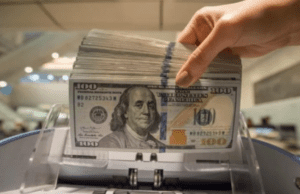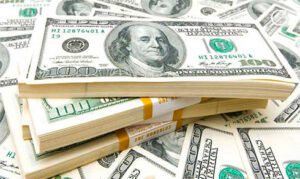
The US dollar is depreciating against the euro, yen and pound sterling in trading on Wednesday, the market awaits the results of a two-day meeting of the Federal Reserve System (Fed).
Traders have no doubt that the rate will be increased by 75 bp following the November meeting. for the fourth time in a row, and their focus is on statements by Fed Chairman Jerome Powell on the further pace of policy tightening.
Signals of persistent inflationary pressures require the US Central Bank to continue to raise rates, but some of its leaders have already made it clear that they consider it necessary to slow down the rate of increase and assess the economic consequences of earlier measures, The Wall Street Journal notes.
Many economists warn of the risks of the Fed tightening too much, which could trigger a severe economic downturn.
“The Fed will have to think about policy adjustments at the November meeting. They are trying to ‘cool’ the economy, not lead it to a deep freeze,” said KPMG chief economist Diane Swank, quoted by the WSJ.
Experts polled by Bloomberg expect the Fed to slow down the rate hike in December to 50 bp, after which it will raise it two more times by 25 bp. at the beginning of 2023.
The ICE-calculated index, which shows the dynamics of the dollar against six currencies (the euro, the Swiss franc, the yen, the Canadian dollar, the pound sterling and the Swedish krona), is losing 0.2% on Wednesday, the broader WSJ Dollar – 0.24%.
The euro/dollar pair is trading at $0.9893 at 9:00 AM, compared to $0.9874 at the market close on Tuesday.
The US dollar against the yen fell to 147.52 yen against 148.24 yen in the previous session.
The pound rose to $1.1510 from $1.1482 on Tuesday.
The Bank of England is also holding a meeting this week, its results will be made public on 3 November. Experts expect the British Central Bank to raise the base rate by 75 bp. – until 3%. The Bank of England did not raise the rate by more than 50 bp. since 1989, notes FT.

The US dollar strengthens against the euro, yen and pound sterling in trading on Monday.
The market is waiting for the meeting of the Federal Reserve System (Fed), which will be held on November 1-2. Traders are confident that the US Central Bank will raise the base interest rate by 75 basis points (bp) following the results of the fourth meeting in a row. As a result, the rate will reach the level of 3.75-4% – the maximum since December 2007.
Traders will be closely watching Fed Chairman Jerome Powell’s statements to see if the US central bank intends to slow down the pace of policy tightening from December, writes the Financial Times newspaper. The global economy is weakening, and experts are already seeing signs that the peak of inflation in the United States has passed. In this regard, investors are increasingly expressing fears that the Fed may overdo it with raising rates and provoke an excessive recession in the economy.
The ICE-calculated index, which shows the dynamics of the dollar against six currencies (the euro, the Swiss franc, the yen, the Canadian dollar, the pound sterling and the Swedish krona), adds 0.08% on Monday, the broader WSJ Dollar – 0.19%.
The euro/dollar pair is trading at $0.9946 as of 8:55 am KSK, compared to $0.9966 at market close on Friday.
The US dollar against the yen rose to 147.92 yen against 147.48 yen in the previous session.
The pound dropped to $1.1592 from $1.1617 on Friday.
The Bank of England is also holding a meeting this week, its results will be made public on 3 November. Experts expect the British Central Bank to raise the base rate by 75 bp. – until 3%. The Bank of England did not raise the rate by more than 50 bp. since 1989, notes FT.
The dollar against the yuan edged up to 7.2698 yuan from 7.2525 yuan at market close on Friday amid weak economic data from China.
The Purchasing Managers’ Index (PMI) for China’s manufacturing industry fell to its lowest level since July of 49.2 in October from 50.1 a month earlier, according to data from the National Bureau of Statistics of the People’s Republic of China (GSO). An index value below 50 points indicates a decline in activity in the sector.
PMI services in China in October fell to 48.7 points, dropping below 50 points for the first time since May.

The US dollar is getting cheaper against the euro and the pound sterling at the auctions on Monday, it is stable against the yen.
The ICE-calculated index, which shows the dynamics of the dollar against six currencies (the euro, the Swiss franc, the yen, the Canadian dollar, the pound sterling and the Swedish krona), is losing 0.29%, the broader WSJ Dollar Index – 0.27%.
The euro/dollar is trading at $0.9750 compared to $0.9722 at the market close on Friday.
The rate of the American currency against the yen is 148.72 yen against 148.75 yen following the results of the previous session.
The pound rose to $1.1272 from $1.1183. On Friday, British Prime Minister Liz Truss fired Chancellor of the Exchequer Quasi Kwarteng, appointing Jeremy Hunt to the post.
According to the Financial Times, several British Conservative MPs and prominent figures from the City of London are calling for Truss herself to step down as prime minister after controversial economic decisions that undermined her credibility.
Britain’s new finance minister told the BBC last Sunday, speaking of the possibility of winding down any of the government’s recent stimulus measures, that “nothing is out of the question.”
Later on Monday, Hunt intends to make a statement regarding the country’s medium-term budget.
The dollar rose against the yuan during trading to 7.1996 yuan from 7.1910 yuan at market close on Friday. Chinese President Xi Jinping, speaking at the 20th Congress of the Chinese Communist Party (CCP), which opened on Sunday, signaled that the country’s authorities would continue their tough policy to contain the spread of COVID-19, which has already seriously weakened the country’s economy this year.

US dollar is stable against the euro, strengthening against the yen and the pound sterling on Friday.
The ICE-calculated index, which shows the dynamics of the dollar against six currencies (the euro, the Swiss franc, the yen, the Canadian dollar, the pound sterling and the Swedish krona), adds 0.03% during trading, the broader WSJ Dollar Index loses 0.02%.
The data of the US Department of Labor published the day before showed a weaker-than-expected slowdown in inflation. The CPI rose in September by 8.2% against the same month last year – the lowest rate in seven months. Experts polled by Trading Economics predicted, on average, a slowdown in inflation to 8.1% from 8.3% in August.
Meanwhile, core inflation, excluding the cost of food and energy (Core CPI) accelerated in September to the highest since August 1982 6.6% in annual terms from 6.3% a month earlier.
Published statistical data have strengthened investors in the opinion that the Federal Reserve System (Fed) will continue the rapid tightening of monetary policy. Now traders are waiting for a sharp rise in the rate of the US Central Bank at each of the two remaining meetings of this year, Bloomberg notes.
The euro/dollar pair is trading at $0.9781 compared to $0.9780 at the close of the previous session.
The US currency against the yen is 147.45 yen against 147.22 yen at the close of the market on Thursday.
The pound fell to $1.1322 from $1.1331 the day before.
British Treasury Secretary Kwazi Kwarteng left Washington, where he was meeting with representatives of the International Monetary Fund (IMF), a day earlier than planned. Experts believe that he may abandon part of the tax cuts he announced earlier in order to prevent an economic crisis in the country, the Financial Times writes.
The newspaper’s sources note that the IMF and finance ministers of several other countries recommended that he quickly abandon plans for tax cuts in order to avoid financial problems in the economy.

The dollar is moderately declining against the euro, but growing against the Japanese yen, renewing its maximum value in 24 years.
The ICE-calculated index, which shows the performance of the US dollar against six currencies (the euro, Swiss franc, yen, Canadian dollar, pound sterling and the Swedish krona), is practically unchanged on Wednesday morning, as is the broader WSJ Dollar.
The euro/dollar pair is trading at $0.9721 by 8:52 p.m. compared to $0.9707 at the close of the session on Tuesday, the euro adds about 0.1%.
Meanwhile, the rate of the American currency against the yen rose by almost 0.3% and amounted to 146.25 yen compared to 145.86 yen the day before. This is the highest rate since August 1998. The last time the yen fell to a 24-year low at the end of September, after which the Japanese Ministry of Finance intervened in the foreign exchange market to support the national currency.
The dollar is strengthening against the yen due to mixed monetary policy rates: while the Fed is actively raising interest rates, the Bank of Japan continues to adhere to extremely soft monetary policy.
The pound rose 0.4% to $1.1012 compared to $1.0968 at the close of the previous session.
Traders are evaluating conflicting signals about the Bank of England’s emergency government bond purchase program.
British Central Bank Chairman Andrew Bailey said that the regulator will complete the purchase of bonds on Friday, as planned. “The essence of interventions to stabilize financial markets is partly that this is a temporary phenomenon,” he said.
However, the Financial Times then wrote, citing three anonymous sources, that the Central Bank privately hinted to representatives of some banks about the possibility of extending the bond purchase program in order to protect UK pension funds from losses.

The US dollar is moderately declining against major world currencies on Thursday morning, investors evaluate the statements of the Federal Reserve Board and statistical data.
The ICE-calculated index, which shows the dynamics of the US dollar against six currencies (the euro, the Swiss franc, the yen, the Canadian dollar, the pound sterling and the Swedish krona), is down 0.2%, the broader WSJ Dollar is down 0.25%.
The euro/dollar pair is trading at $0.9920 by 9:08 Moscow time compared to $0.9885 at the close of the session on Wednesday, the euro adds about 0.35%.
The exchange rate of the American currency against the yen is reduced by 0.1% and amounts to 144.53 yen compared to 144.69 yen the day before.
The pound rose 0.1% to $1.1335 compared to $1.1327 at the close of the previous session.
The day before, the head of the Federal Reserve Bank of Atlanta, Rafael Bostic, said that he supports raising the key interest rate in the US by another 125 basis points by the end of the year, to 4.5%.
Meanwhile, San Francisco Fed colleague Mary Daly told CNN that the central bank should raise borrowing costs even higher and keep them high until inflation starts approaching 2%.
It became known yesterday that the index of business activity in the US services sector (ISM Non-Manufacturing) in September decreased to 56.7 points compared to 56.9 points a month earlier, data from the Institute of Supply Management (ISM) showed. Analysts, on average, assumed a more significant drop, to 56 points, according to Trading Economics.
Now all the attention of market participants is directed to data on the US labor market, which will be published on Friday. Experts believe that the unemployment rate in the country in September remained at the August mark of 3.7%, and the number of new jobs increased by 315 thousand people.